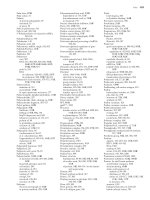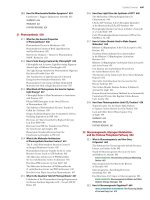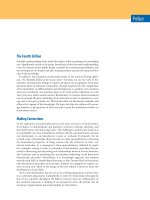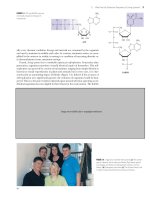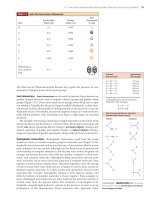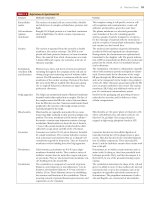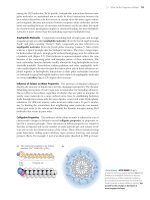Biochemistry, 4th Edition P18 pot
Bạn đang xem bản rút gọn của tài liệu. Xem và tải ngay bản đầy đủ của tài liệu tại đây (934.82 KB, 10 trang )
Chapter 5 Appendix 133
where
p
is the density of the particle or macromolecule,
m
is the density of the
medium or solution, V is the volume of the particle, and f is the frictional coeffi-
cient, given by
ƒ ϭ F
f
/v
where v is the velocity of the particle and F
f
is the frictional drag. Nonspherical mol-
ecules have larger frictional coefficients and thus smaller sedimentation coeffi-
cients. The smaller the particle and the more its shape deviates from spherical, the
more slowly that particle sediments in a centrifuge.
Centrifugation can be used either as a preparative technique for separating and
purifying macromolecules and cellular components or as an analytical technique to
characterize the hydrodynamic properties of macromolecules such as proteins and
nucleic acids.
National Archaeological Museum, Athens, Greece/Bridgeman
Art Library
6
Proteins: Secondary,Tertiary,
and Quaternary Structure
Nearly all biological processes involve the specialized functions of one or more pro-
tein molecules. Proteins function to produce other proteins, control all aspects of
cellular metabolism, regulate the movement of various molecular and ionic species
across membranes, convert and store cellular energy, and carry out many other ac-
tivities. Essentially all of the information required to initiate, conduct, and regulate
each of these functions must be contained in the structure of the protein itself. The
previous chapter described the details of protein primary structure. However, pro-
teins do not normally exist as fully extended polypeptide chains but rather as com-
pact structures that biochemists refer to as “folded.” The ability of a particular pro-
tein to carry out its function in nature is normally determined by its overall
three-dimensional shape, or conformation.
This chapter reveals and elaborates upon the exquisite beauty of protein struc-
tures. What will become apparent in this discussion is that the three-dimensional
structure of proteins and their biological function are linked by several overarching
principles:
1. Function depends on structure.
2. Structure depends both on amino acid sequence and on weak, noncovalent
forces.
3. The number of protein folding patterns is very large but finite.
4. The structures of globular proteins are marginally stable.
5. Marginal stability facilitates motion.
6. Motion enables function.
6.1 What Noncovalent Interactions Stabilize the Higher
Levels of Protein Structure?
The amino acid sequence (primary structure) of any protein is dictated by covalent
bonds, but the higher levels of structure—secondary, tertiary, and quaternary—are
formed and stabilized by weak, noncovalent interactions (Figure 6.1). Hydrogen
bonds, hydrophobic interactions, electrostatic bonds, and van der Waals forces are all
noncovalent in nature, yet they are extremely important influences on protein con-
formation. The stabilization free energies afforded by each of these interactions may
be highly dependent on the local environment within the protein, but certain gener-
alizations can still be made.
Hydrogen Bonds Are Formed Whenever Possible
Hydrogen bonds are generally made wherever possible within a given protein
structure. In most protein structures that have been examined to date, component
atoms of the peptide backbone tend to form hydrogen bonds with one another.
Like the Greek sea god Proteus, who could assume
different forms, proteins act through changes in con-
formation. Proteins (from the Greek proteios, meaning
“primary”) are the primary agents of biological func-
tion. (“Proteus,Old Man of the Sea, Roman period mosaic,
from Thessalonika,1st century a.d. National Archaeologi-
cal Museum,Athens/Ancient Art and Architecture Collec-
tion Ltd./Bridgeman Art Library,London/New York)
Growing in size and complexity
Living things, masses of atoms, DNA, protein
Dancing a pattern ever more intricate.
Out of the cradle onto the dry land
Here it is standing
Atoms with consciousness
Matter with curiosity.
Stands at the sea
Wonders at wondering
I
A universe of atoms
An atom in the universe.
Richard P. Feynman (1918–1988)
From “The Value of Science” in Edward Hutchings,
Jr., ed. 1958. Frontiers of Science: A Survey.
New York: Basic Books.
KEY QUESTIONS
6.1 What Noncovalent Interactions Stabilize the
Higher Levels of Protein Structure?
6.2 What Role Does the Amino Acid Sequence
Play in Protein Structure?
6.3 What Are the Elements of Secondary Structure
in Proteins, and How Are They Formed?
6.4 How Do Polypeptides Fold into Three-
Dimensional Protein Structures?
6.5 How Do Protein Subunits Interact at the
Quaternary Level of Protein Structure?
ESSENTIAL QUESTION
Linus Pauling received the Nobel Prize in Chemistry in 1954. The award cited “his
research into the nature of the chemical bond and its application to the elucidation
of the structure of complex substances.” Pauling pioneered the study of secondary
structure in proteins.
How do the forces of chemical bonding determine the formation, stability,
and myriad functions of proteins?
Create your own study path for
this chapter with tutorials, simulations, animations,
and Active Figures at www.cengage.com/ login
6.1 What Noncovalent Interactions Stabilize the Higher Levels of Protein Structure? 135
Furthermore, side chains capable of forming H bonds are usually located on the
protein surface and form such bonds either with the water solvent or with other
surface residues. The strengths of hydrogen bonds depend to some extent on en-
vironment. The difference in energy between a side chain hydrogen bonded to wa-
ter and that same side chain hydrogen bonded to another side chain is usually
quite small. On the other hand, a hydrogen bond in the protein interior, away
from bulk solvent, can provide substantial stabilization energy to the protein. Al-
though each hydrogen bond may contribute an average of only a few kilojoules per
mole in stabilization energy for the protein structure, the number of H bonds
formed in the typical protein is very large. For example, in ␣-helices, the CPO and
NOH groups of every interior residue participate in H bonds. The importance of
H bonds in protein structure cannot be overstated.
Hydrophobic Interactions Drive Protein Folding
Hydrophobic “bonds,” or, more accurately, interactions, form because nonpolar side
chains of amino acids and other nonpolar solutes prefer to cluster in a nonpolar en-
vironment rather than to intercalate in a polar solvent such as water. The forming
of hydrophobic “bonds” minimizes the interaction of nonpolar residues with water
and is therefore highly favorable. Such clustering is entropically driven, and it is in
fact the principal impetus for protein folding. The side chains of the amino acids in
the interior or core of the protein structure are almost exclusively hydrophobic. Po-
lar amino acids are much less common in the interior of a protein, but the protein
surface may consist of both polar and nonpolar residues.
Ionic Interactions Usually Occur on the Protein Surface
Ionic interactions arise either as electrostatic attractions between opposite charges
or repulsions between like charges. Chapter 4 discusses the ionization behavior of
amino acids. Amino acid side chains can carry positive charges, as in the case of ly-
sine, arginine, and histidine, or negative charges, as in aspartate and glutamate. In
addition, the N-terminal and C-terminal residues of a protein or peptide chain usu-
ally exist in ionized states and carry positive or negative charges, respectively. All of
these may experience ionic interactions in a protein structure. Charged residues are
normally located on the protein surface, where they may interact optimally with the
water solvent. It is energetically unfavorable for an ionized residue to be located in
the hydrophobic core of the protein. Ionic interactions between charged groups on
a protein surface are often complicated by the presence of salts in the solution. For
example, the ability of a positively charged lysine to attract a nearby negative gluta-
mate may be weakened by dissolved salts such as NaCl (Figure 6.1). The Na
ϩ
and
Cl
Ϫ
ions are highly mobile, compact units of charge, compared to the amino acid
side chains, and thus compete effectively for charged sites on the protein. In this
CH
2
CH
2
CH
2
CH
2
NH
3
Main chain
Lysine
H
2
O
H
2
O
Na
+
HC
CO
NH
CO
OC
C
O
CH
2
CH
2
CH
O
HN
NH
CO
Cl
–
Cl
–
Na
+
Main chain
Glutamate
+–
HN
FIGURE 6.1 An electrostatic interaction between the ⑀-amino group of a lysine and the ␥-carboxyl group of a
glutamate.The protein is IRAK-4 kinase, an enzyme that phosphorylates other proteins (pdb id ϭ 2NRY).The
interaction shown is between Lys
213
(left) and Glu
233
(right).
136 Chapter 6 Proteins: Secondary,Tertiary, and Quaternary Structure
manner, ionic interactions among amino acid residues on protein surfaces may be
damped out by high concentrations of salts. Nevertheless, these interactions are im-
portant for protein stability.
Van der Waals Interactions Are Ubiquitous
Both attractive forces and repulsive forces are included in van der Waals interactions.
The attractive forces are due primarily to instantaneous dipole-induced dipole inter-
actions that arise because of fluctuations in the electron charge distributions of adja-
cent nonbonded atoms. Individual van der Waals interactions are weak ones (with sta-
bilization energies of 0.4 to 4.0 kJ/mol), but many such interactions occur in a typical
protein, and by sheer force of numbers, they can represent a significant contribution
to the stability of a protein. Peter Privalov and George Makhatadze have shown that,
for pancreatic ribonuclease A, hen egg white lysozyme, horse heart cytochrome c, and
sperm whale myoglobin, van der Waals interactions between tightly packed groups in
the interior of the protein are a major contribution to protein stability.
6.2 What Role Does the Amino Acid Sequence Play
in Protein Structure?
It can be inferred from the first section of this chapter that many different forces
work together in a delicate balance to determine the overall three-dimensional struc-
ture of a protein. These forces operate both within the protein structure itself and
between the protein and the water solvent. How, then, does nature dictate the man-
ner of protein folding to generate the three-dimensional structure that optimizes
and balances these many forces? All of the information necessary for folding the peptide
chain into its “native” structure is contained in the amino acid sequence of the peptide.
Just how proteins recognize and interpret the information that is stored in the
amino acid sequence is not yet well understood. Certain loci along the peptide
chain may act as nucleation points, which initiate folding processes that eventually
lead to the correct structures. Regardless of how this process operates, it must take
the protein correctly to the final native structure. Along the way, local energy-
minimum states different from the native state itself must be avoided. A long-range
goal of many researchers in the protein structure field is the prediction of three-
dimensional conformation from the amino acid sequence. As the details of sec-
ondary and tertiary structure are described in this chapter, the complexity and
immensity of such a prediction will be more fully appreciated. This area is one of
the greatest uncharted frontiers remaining in molecular biology.
6.3 What Are the Elements of Secondary Structure
in Proteins, and How Are They Formed?
Any discussion of protein folding and structure must begin with the peptide bond, the
fundamental structural unit in all proteins. As we saw in Chapter 4, the resonance
structures experienced by a peptide bond constrain six atoms—the oxygen, carbon,
nitrogen, and hydrogen atoms of the peptide group, as well as the adjacent
␣-carbons—to lie in a plane. The resonance stabilization energy of this planar struc-
ture is approximately 88 kJ/mol, and substantial energy is required to twist the
structure about the CON bond. A twist of degrees involves a twist energy of
88 sin
2
kJ/mol.
All Protein Structure Is Based on the Amide Plane
The planarity of the peptide bond means that there are only two degrees of free-
dom per residue for the peptide chain. Rotation is allowed about the bond linking
the ␣-carbon and the carbon of the peptide bond and also about the bond linking
6.3 What Are the Elements of Secondary Structure in Proteins, and How Are They Formed? 137
the nitrogen of the peptide bond and the adjacent ␣-carbon. As shown in Figure
6.2, each ␣-carbon is the joining point for two planes defined by peptide bonds. The
angle about the C
␣
ON bond is denoted by the Greek letter (phi), and that about
the C
␣
OC
o
is denoted by (psi). For either of these bond angles, a value of 0° cor-
responds to an orientation with the amide plane bisecting the HOC
␣
OR (side-
chain) angle and a cis conformation of the main chain around the rotating bond in
question (Figure 6.3).
The entire path of the peptide backbone in a protein is known if the and
rotation angles are all specified. Some values of and are not allowed due to
steric interference between nonbonded atoms. As shown in Figure 6.3, values of
ϭ 180° and ϭ 0° are not allowed because of the forbidden overlap of the NOH
hydrogens. Similarly, ϭ 0° and ϭ 180° are forbidden because of unfavorable
overlap between the carbonyl oxygens.
G. N. Ramachandran and his co-workers in Madras, India, demonstrated that it was
convenient to plot values against values to show the distribution of allowed values
in a protein or in a family of proteins. A typical Ramachandran plot is shown in Fig-
ure 6.4. Note the clustering of and values in a few regions of the plot. Most com-
binations of and are sterically forbidden, and the corresponding regions of the
Ramachandran plot are sparsely populated. The combinations that are sterically al-
lowed represent the subclasses of structure described in the remainder of this section.
The Alpha-Helix Is a Key Secondary Structure
As noted in Chapter 5, the term secondary structure describes local conformations of
the polypeptide that are stabilized by hydrogen bonds. In nearly all proteins, the
hydrogen bonds that make up secondary structures involve the amide proton of
one peptide group and the carbonyl oxygen of another, as shown in Figure 6.5.
These structures tend to form in cooperative fashion and involve substantial por-
tions of the peptide chain. When a number of hydrogen bonds form between por-
tions of the peptide chain in this manner, two basic types of structures can result:
␣-helices and -pleated sheets.
R
H
Amide
plane
C
C
C
C
C
O
N
N
H
H
␣-Carbon
Side group
Amide plane
= 180°, =180°
O
Nonbonded
contact
radius
= 0°, = 180°
H
C
␣
N
C
a
H
O
C
O
H
N
R
C
a
C
N
C
a
H
O
O
H
N
R
N
H
H
O
O
H
N
R
N
H
H
Nonbonded
contact
radius
= 180°, = 0°
A further rotation of 120°
removes the bulky carbonyl
group as far as possible
from the side chain
= 0°, = 0°
O
C
␣
= –60°, = 180°
H
O
N
R
H
N
H
O
O
C
␣
C
a
C
C
C
C
C
a
C
a
C
a
C
a
C
a
C
a
C
a
C
a
C
C
ACTIVE FIGURE 6.3 Many of the possible conformations about an ␣-carbon between two
peptide planes are forbidden because of steric crowding.Several noteworthy examples are shown here.
Note: The formal IUPAC-IUB Commission on Biochemical Nomenclature convention for the definition of the
torsion angles and in a polypeptide chain (Biochemistry 9:3471–3479,1970) is different from that used here, where
the C
␣
atom serves as the point of reference for both rotations,but the result is the same.
(Illustration: Irving Geis. Rights
owned by Howard Hughes Medical Institute. Not to be reproduced without permission.)
Test yourself on the concepts in
this figure at www.cengage.com/login.
FIGURE 6.2 The amide or peptide bond planes are
joined by the tetrahedral bonds of the ␣-carbon.The
rotation parameters are and .The conformation
shown corresponds to ϭ 180° and ϭ 180°. Note
that positive values of and correspond to clockwise
rotation as viewed from C
␣
. Starting from 0°, a rotation
of 180° in the clockwise direction (ϩ180°) is equivalent
to a rotation of 180° in the counterclockwise direction
(Ϫ180°). (Illustration: Irving Geis. Rights owned by Howard
Hughes Medical Institute. Not to be reproduced without
permission.)
138 Chapter 6 Proteins: Secondary,Tertiary, and Quaternary Structure
180
90
–180
0
–90
(deg)
–180 –90 0 90 180
(deg)
␣
II
C
2
L
3
α
π
Antiparallel -sheet
Parallel -sheet
Collagen
triple helix
Right-handed
␣-helix
Closed ring
Left-handed
␣-helix
+4
+5
–5
–4
–3
n = 2
+3
+4
+5
–5
–4
ACTIVE FIGURE 6.4 A Ramachandran
diagram showing the sterically reasonable values of the
angles and .The shaded regions indicate particularly
favorable values of these angles. Dots in purple indicate
actual angles measured for 1000 residues (excluding
glycine, for which a wider range of angles is permitted)
in eight proteins.The lines running across the diagram
(numbered ϩ5 through 2 and Ϫ5 through Ϫ3) signify
the number of amino acid residues per turn of the helix;
“ϩ”means right-handed helices; “Ϫ” means left-handed
helices.
(After Richardson, J. S., 1981.The anatomy and taxono-
my of protein structure. Advances in Protein Chemistry
34:167–339.)
Test yourself on the concepts in this
figure at www.cengage.com/login.
A DEEPER LOOK
Knowing What the Right Hand and Left Hand Are Doing
Certain conventions related to peptide bond angles and the “hand-
edness” of biological structures are useful in any discussion of pro-
tein structure. To determine the and angles between peptide
planes, viewers should imagine themselves at the C
␣
carbon looking
outward and should imagine starting from the ϭ 0°, ϭ 0° con-
formation. From this perspective, positive values of correspond to
clockwise rotations about the C
␣
ON bond of the plane that includes
the adjacent NOH group. Similarly, positive values of correspond
to clockwise rotations about the C
␣
OC bond of the plane that in-
cludes the adjacent CPO group.
Biological structures are often said to exhibit “right-hand” or
“left-hand” twists. For all such structures, the sense of the twist can
be ascertained by holding the structure in front of you and looking
along the polymer backbone. If the twist is clockwise as one pro-
ceeds outward and through the structure, it is said to be right-
handed. If the twist is counterclockwise, it is said to be left-handed.
6.3 What Are the Elements of Secondary Structure in Proteins, and How Are They Formed? 139
The earliest studies of protein secondary structure were those of William Ast-
bury at the University of Leeds. Astbury carried out X-ray diffraction studies on
wool and observed differences between unstretched wool fibers and stretched
wool fibers. He proposed that the protein structure in unstretched fibers was a he-
lix (which he called the alpha form). He also proposed that stretching caused the
helical structures to uncoil, yielding an extended structure (which he called the
beta form). Astbury was the first to propose that hydrogen bonds between peptide
groups contributed to stabilizing these structures.
In 1951, Linus Pauling, Robert Corey, and their colleagues at the California In-
stitute of Technology summarized a large volume of crystallographic data in a set
of dimensions for polypeptide chains. (A summary of data similar to what they
reported is shown in Figure 4.15.) With these data in hand, Pauling, Corey, and
their colleagues proposed a new model for a helical structure in proteins, which
they called the ␣-helix. The report from Caltech was of particular interest to Max
Perutz in Cambridge, England, a crystallographer who was also interested in pro-
tein structure. By taking into account a critical but previously ignored feature of
the X-ray data, Perutz realized that the ␣-helix existed in keratin, a protein from
hair, and also in several other proteins. Since then, the ␣-helix has proved to be a
fundamentally important peptide structure. Several representations of the ␣-helix
are shown in Figure 6.6. One turn of the helix represents 3.6 amino acid residues.
(A single turn of the ␣-helix involves 13 atoms from the O to the H of the H bond.
For this reason, the ␣-helix is sometimes referred to as the 3.6
13
helix.) This is in
fact the feature that most confused crystallographers before the Pauling and
Corey ␣-helix model. Crystallographers were so accustomed to finding twofold,
threefold, sixfold, and similar integral axes in simpler molecules that the notion
of a nonintegral number of units per turn was never taken seriously before Paul-
ing and Corey’s work.
Each amino acid residue extends 1.5 Å (0.15 nm) along the helix axis. With
3.6 residues per turn, this amounts to 3.6 ϫ 1.5 Å or 5.4 Å (0.54 nm) of travel along
the helix axis per turn. This is referred to as the translation distance or the pitch of
the helix. If one ignores side chains, the helix is about 6 Å in diameter. The side
chains, extending outward from the core structure of the helix, are removed from
R
N
N
C
C
C
C
C
C
O
O
N
N
C
R
C
O
C
C
O
FIGURE 6.5 A hydrogen bond between the backbone CPO of Ala
191
and
the backbone NOH of Ser
147
in the acetylcholine-binding protein of a snail,
Lymnaea stagnalis (pdb id ϭ 1I9B).
Go to CengageNOW at www
.cengage.com/login and click BiochemistryInteractive
to explore the anatomy of the ␣-helix.
140 Chapter 6 Proteins: Secondary,Tertiary, and Quaternary Structure
steric interference with the polypeptide backbone. As can be seen in Figure 6.6,
each peptide carbonyl is hydrogen bonded to the peptide NOH group four residues farther up
the chain. Note that all of the H bonds lie parallel to the helix axis and all of the car-
bonyl groups are pointing in one direction along the helix axis while the NOH
groups are pointing in the opposite direction. Recall that the entire path of the pep-
tide backbone can be known if the and twist angles are specified for each
residue. The ␣-helix is formed if the values of are approximately Ϫ60° and the val-
ues of are in the range of Ϫ45 to Ϫ50°. Figure 6.7 shows the structures of two pro-
teins that contain ␣-helical segments. The number of residues involved in a given
␣-helix varies from helix to helix and from protein to protein. On average, there are
about 10 residues per helix. Myoglobin, one of the first proteins in which ␣-helices
were observed, has eight stretches of ␣-helix that form a box to contain the heme
prosthetic group (see Figure 5.1).
As shown in Figure 6.6, all of the hydrogen bonds point in the same direction
along the ␣-helix axis. Each peptide bond possesses a dipole moment that arises
from the polarities of the NOH and CPO groups, and because these groups are all
aligned along the helix axis, the helix itself has a substantial dipole moment, with a
partial positive charge at the N-terminus and a partial negative char
ge at the
C-terminus (Figure 6.8). Negatively charged ligands (e.g., phosphates) frequently
bind to proteins near the N-terminus of an ␣-helix. By contrast, positively charged
ligands are only rarely found to bind near the C-terminus of an ␣-helix.
In a typical ␣-helix of 12 (or n) residues, there are 8 (or n Ϫ 4) hydrogen bonds.
As shown in Figure 6.9, the first 4 amide hydrogens and the last 4 carbonyl oxygens
(d)
Hydrogen bonds stabilize
the helix structure.
The helix can be viewed
as a stacked array of
peptide planes hinged
at the α-carbons and
approximately parallel
to the helix.
(a) (b) (c)
α-Carbon
Side group
FIGURE 6.6 Four different graphic representations of the ␣-helix.(a) A stick representation with H bonds as dotted
lines, as originally conceptualized in Pauling’s 1960 The Nature of the Chemical Bond. (b) Showing the arrangement
of peptide planes in the helix. (Illustration: Irving Geis. Rights owned by Howard Hughes Medical Institute. Not to be repro-
duced without permission.)
(c) A space-filling computer graphic presentation. (d) A “ribbon structure”with an inlaid
stick figure, showing how the ribbon indicates the path of the polypeptide backbone.
6.3 What Are the Elements of Secondary Structure in Proteins, and How Are They Formed? 141
-Hemoglobin subunit Myohemerythrin
ANIMATED FIGURE 6.7 The three-
dimensional structures of two proteins that contain sub-
stantial amounts of ␣-helix in their structures.The helices
are represented by the regularly coiled sections of the
ribbon drawings. Myohemerythrin is the oxygen-carrying
protein in certain invertebrates, including Sipunculids, a
phylum of marine worm. -Hemoglobin subunit: pdb
id ϭ 1HGA; myohemerythrin pdb id ϭ 1A7D.(Jane
Richardson.)
See this figure animated at www.cengage
.com/login.
–0.42
+0.42
–0.20
+0.20
–
+
Dipole
moment
(a)
(b)
C
N
H
O
FIGURE 6.8 The arrangement of NOH and CPO
groups (each with an individual dipole moment)
along the helix axis creates a large net dipole for the
helix. Numbers indicate fractional charges on re-
spective atoms.
3.6
residues
C
␣8
C
␣7
C
␣5
C
␣3
C
␣2
C
␣1
C
␣4
C
␣6
O
N
H
C
␣9
FIGURE 6.9 Four NOH groups at the N-terminal end of
an ␣-helix and four CPO groups at the C-terminal end
lack partners for H-bond formation.The formation of
H bonds with other nearby donor and acceptor groups
is referred to as helix capping. Capping may also in-
volve appropriate hydrophobic interactions that accom-
modate nonpolar side chains at the ends of helical
segments.
142 Chapter 6 Proteins: Secondary,Tertiary, and Quaternary Structure
cannot participate in helix H bonds. Also, nonpolar residues situated near the he-
lix termini can be exposed to solvent. Proteins frequently compensate for these
problems by helix capping—providing H-bond partners for the otherwise bare
NOH and CPO groups and folding other parts of the protein to foster hydropho-
bic contacts with exposed nonpolar residues at the helix termini.
Careful studies of the polyamino acids, polymers in which all the amino acids
are identical, have shown that certain amino acids tend to occur in ␣-helices,
whereas others are less likely to be found in them. Polyleucine and polyalanine,
for example, readily form ␣-helical structures. In contrast, polyaspartic acid and
polyglutamic acid, which are highly negatively charged at pH 7.0, form only ran-
dom structures because of strong charge repulsion between the R groups along
the peptide chain. At pH 1.5 to 2.5, however, where the side chains are protonated
and thus uncharged, these latter species spontaneously form ␣-helical structures.
In similar fashion, polylysine is a random coil at pH values below about 11, where
repulsion of positive charges prevents helix formation. At pH 12, where polylysine
is a neutral peptide chain, it readily forms an ␣-helix.
The tendencies of various amino acids to stabilize or destabilize ␣-helices are dif-
ferent in typical proteins than in polyamino acids. The occurrence of the common
amino acids in helices is summarized in Table 6.1. Notably, proline (and hydrox-
yproline) act as helix breakers due to their unique structure, which fixes the value
of the C
␣
ONOC bond angle. Helices can be formed from either D- or L-amino
acids, but a given helix must be composed entirely of amino acids of one configu-
ration. ␣-Helices cannot be formed from a mixed copolymer of
D- and L-amino
acids. An ␣-helix composed of
D-amino acids is left-handed.
The -Pleated Sheet Is a Core Structure in Proteins
Another type of structure commonly observed in proteins also forms because of
local, cooperative formation of hydrogen bonds. That is the pleated sheet, or
-structure, often called the -pleated sheet. This structure was also first postulated
Amino Acid Helix Behavior*
A Ala H (I)
C Cys Variable
D Asp Variable
E Glu H
F Phe H
G Gly I (B)
H His H (I)
I Ile H (C)
K Lys Variable
L Leu H
M Met H
N Asn C (I)
P Pro B
Q Gln H (I)
RArg H (I)
S Ser C (B)
T Thr Variable
V Val Variable
W Trp H (C)
Y Tyr H (C)
*H ϭ helix former; I ϭ indifferent; B ϭ helix breaker; C ϭ random coil; ( ) ϭ secondary tendency.
TABLE 6.1
Helix-Forming and Helix-Breaking Behavior of the Amino Acids
